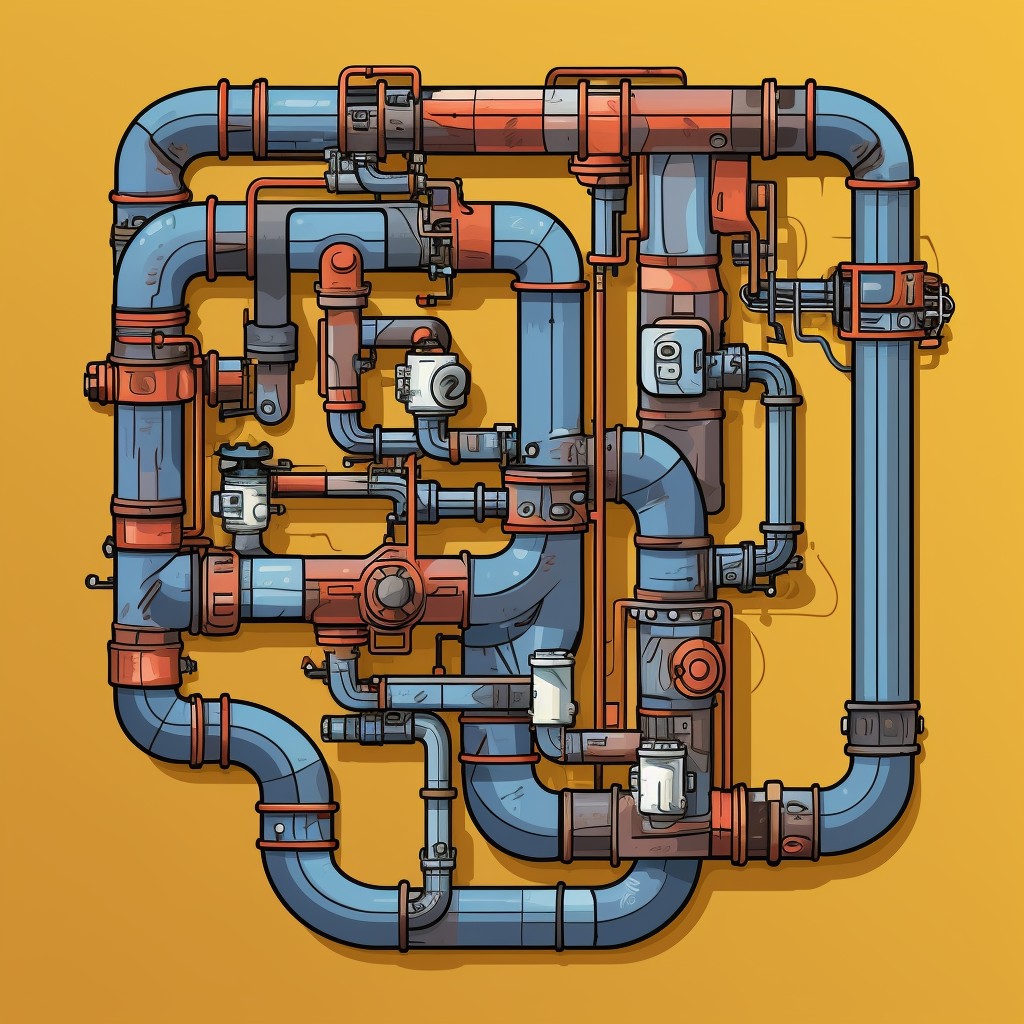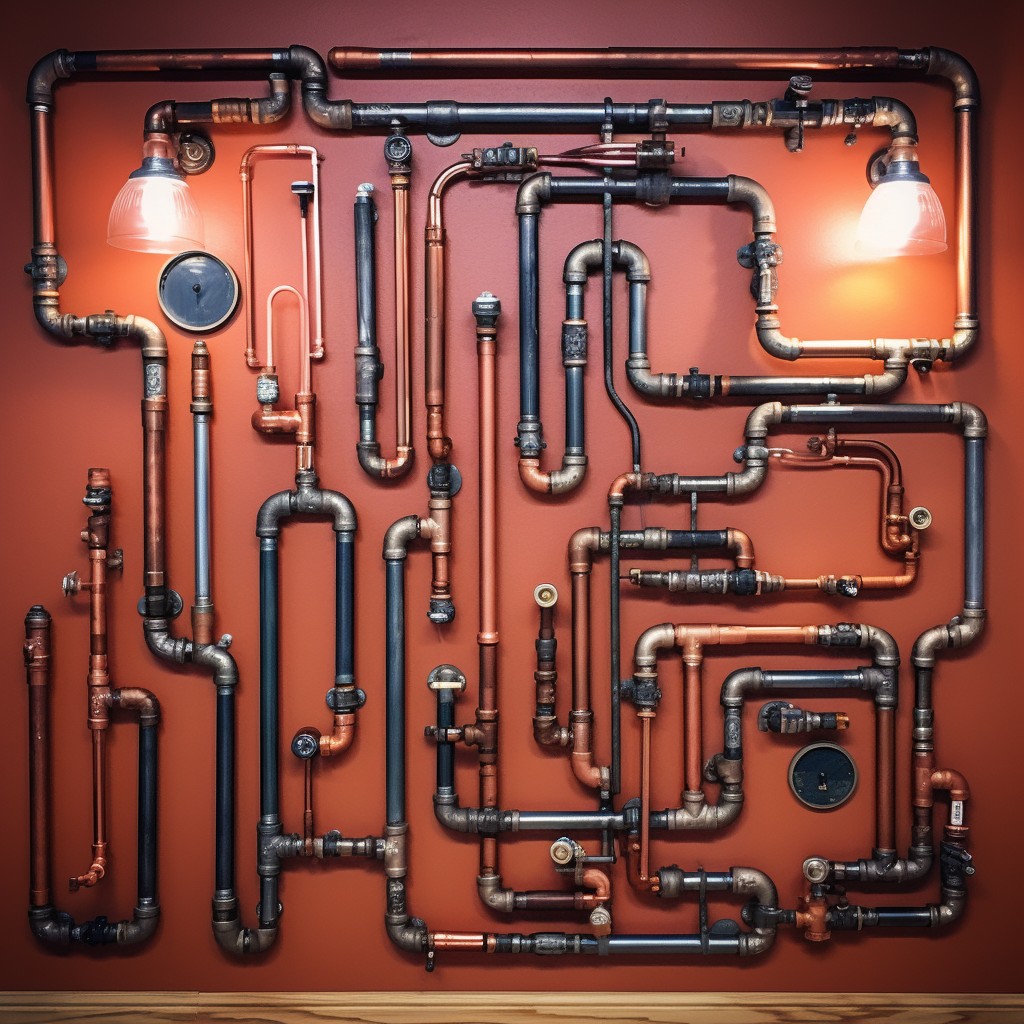Last updated on
Discover the indispensable role of right angle plumbing pipes in the construction and plumbing industry because they offer ingenious solutions to complex piping challenges.
A right-angle plumbing pipe, often referred to as an elbow fitting, is a crucial component in many plumbing systems. This pipe fitting is designed to connect two pipes at a 90-degree angle, allowing water to flow around corners without the need for additional tubing or complex installations.
It’s typically used in areas where space is limited or where a change in direction is required. This article will delve deeper into the function, types, and uses of right-angle plumbing pipes, providing a comprehensive understanding of this essential plumbing component.
Key takeaways:
- Right angle plumbing pipes connect two pipes at a 90-degree angle.
- Types include elbow, tee, and cross fittings.
- Materials used include PVC, ABS, brass, copper, and stainless steel.
- Installation requires clean pipes, pipe dope or Teflon tape, alignment, and proper tightening.
- Common uses include redirecting pipes in renovations and complex plumbing systems.
Table of Contents
Definition of a Right Angle Plumbing Pipe

A right angle plumbing pipe is essentially a type of fitting that connects two pipes at a 90-degree angle. One pipe plugs into the other at an angle, allowing for smooth redirection of the water or waste flow without a decrease in pressure or efficiency. It plays an integral role when the pipeline needs to avoid obstacles or when the layout of the property necessitates a sharp turn in the piping system.
These right angle fittings, often referred to as “elbows” or “ells,” are a staple in both residential and industrial plumbing setups. Depending on the specific need and positioning, these can either be a male (externally threaded) or female (internally threaded) type of pipe fitting. Sometimes they might also have one unthreaded end to allow for a welded or solvent-welded connection.
Varieties in Types and Sizes of Right Angle Plumbing Pipes

A multitude of choices abounds when it comes to types and sizes to suit specific needs. The three primary categories include elbow, tee, and cross type. Each serves a unique function, with elbow-type pipes allowing for a 90-degree turn, tee-type pipes facilitating connections of three pipe sections, and cross-type allowing connections of four sections.
Right angle plumbing pipes come in varying sizes, typically denoted in inches. They range from compact sizes such as quarter inch or half inch, ideal for smaller projects or tight spaces, to larger sizes like 2 inch and beyond, accommodating greater volumes of water flow.
It’s crucial to remember that correct sizing is vital. A carefully chosen size not only aids optimal functionality of the plumbing system but also minimizes potential issues such as leaks or restricted flow. This ensures the longevity of your plumbing system, contributing to a hassle-free home or business environment.
Materials Used in Manufacturing Right Angle Plumbing Pipes
The industry manufactures these pipes from a wide variety of materials, each with its unique set of advantages. PVC, notably recognized for its corrosion resistance and ease of installation, commonly serves in residential plumbing.
ABS, another plastic variant, often functions in low-temperature applications due to its resistance to cracking in cold climates.
Brass and copper right-angle pipes, known for enduring high temperatures and pressures, often come handy in hot water distribution systems.
Stainless steel, although expensive, serves well in commercial applications, resisting corrosive substances and providing longevity.
It’s necessary to choose the material based on the project’s specific requirements, ensuring optimal performance.
Installation Process of a Right Angle Plumbing Pipe
To begin, ensure the pipes to be connected are clean and debris-free. Apply a thin layer of pipe dope or Teflon tape to the threads of the male fitting. This helps to seal the connection and prevent leaks.
Position the right angle pipe carefully, making sure the ends line up properly with the other pipes.
Use an adjustable wrench to tighten the fitting. Turn the wrench in a clockwise direction until the fitting is tight. However, avoid overtightening as this can lead to thread stripping or pipe damage.
Once fitted, consider using a pipe strap to provide additional support if the piping network will bear a heavy load or is high off the ground.
Remember, if you’re not comfortable with the process or the task seems too complicated, it’s wise to call in a professional plumber who can efficiently handle the installation for you. Always prioritize safety and accuracy over haste when dealing with plumbing tasks.
Common Scenarios for Using Right Angle Plumbing Pipes
These versatile pieces often come into use in both residential and commercial plumbing projects.
In homes, they are mainly installed to redirect the pipe route when renovating a bathroom or kitchen, aiding in the movement of water in different directions. They can also help in making awkward corner installations seamless, such as under sinks and behind toilets, keeping those pipes compact and tidy.
Commercial spaces, like restaurants or hotels, also benefit from these plumbing components. The intricate plumbing systems of these establishments often require complex routing, a situation where right angle pipes prove invaluable.
In outdoor settings, particularly for irrigation systems, these pipes ensure water is delivered efficiently to designated areas.
These key scenarios demonstrate the vital role right angle plumbing pipes play in controlling and directing the flow of water while minimizing space requirements. Their purpose extends beyond just redirects, they offer flexibility in design, making them an integral part of any plumber’s tool kit.
Troubleshooting Common Issues With Right Angle Plumbing Pipes
Understanding the early signs of trouble can prevent further damage and costly repairs. There are a few issues that commonly occur with right angle plumbing pipes.
1. Leaks: Often noticeable due to water pooling in the area, leaks can occur due to several reasons such as loosened connections or wear and tear over time. It might be a simple fix like tightening the connection or replacing the washer, yet, at times, professional help may be warranted.
2. Clogs: Blockages in pipes lead to restricted water flow. Regular flushing and cleaning of the pipes aids in preventing this problem. Stubborn clogs may require the use of a plumber’s snake or the intervention of a skilled plumber.
3. Corrosion: Over time, pipes may corrode, leading to leaks and water discoloration. Regular inspection helps to detect early signs of corrosion and taking prompt action mitigates further deterioration.
4. Incorrect Installation: Incorrectly installed right angle plumbing pipes can cause numerous issues, including leaks, noisy pipes, and uneven water flow. It’s critical to ensure that the pipe is correctly installed and aligned, providing seamless water flow.
Remember, understanding these common issues and acting promptly saves time, energy, and money in the long run. It’s all about being attentive and proactive!
Maintenance Tips for Right Angle Plumbing Pipes
Regular inspection is paramount to ensuring your right angle pipes are in top shape. Look for signs of wear or corrosion, particularly near the joints. A straightforward flashlight inspection can do the trick.
Use only non-abrasive cleaning agents when scrubbing the exterior of the pipes to prevent damages. Rubber gloves are recommended for the task.
In case of clogs, refrain from harsh chemicals as they may cause damage over time. Instead, opt for a plumbing snake, or a plunger in minor cases.
Be mindful of the temperature. Very high or low temperatures can induce strain on the pipes. If your plumbing system is exposed to outdoor elements, consider insulating them to help maintain a steady temperature.
It’s recommended to seek professional assistance if you come across any significant issues like leaks. Addressing these problems promptly ensures the durability of the right angle pipes and longevity of the entire plumbing system. Always remember, preventive care is better—and often cheaper—than a major repair.
FAQ
What is a pipe fitting in the shape of a right angle?
A pipe fitting in the shape of a right angle is referred to as a Pipe Tee fitting.
What is a right angle bend for joining two pipes?
A right angle bend for joining two pipes is a miter bend, made by cutting two pipes at 45 degrees and joining them by welding.
What is the best pipe for plumbing a house?
The best pipe for plumbing a house is the Chlorinated Polyvinyl Chloride (CPVC) pipe due to its flexibility, ease of installation, cost-effectiveness, and resistance to corrosion.
What is the best pipe for outdoor water lines?
The best pipe for outdoor water lines, particularly for non-potable water supply, irrigation, and drainage systems, is the PVC pipe due to its lightweight, corrosion-resistance, and durability, resistance to most chemicals and roots, as well as its relative ease of installation and cost-effectiveness.
What are the primary uses of a right angle pipe in home plumbing?
A right-angle pipe, also known as an elbow pipe, is primarily used in home plumbing to change the direction of flow, which is essential in spaces with limited room or specific construction requirements.
How does the installation of a right angle pipe differ from other pipe fittings?
The installation of a right angle pipe fitting, commonly known as an elbow fitting, differs as it requires precise alignment to ensure an accurate 90-degree connection, unlike other straight or T-shaped pipe fittings.
What are the different materials available for right angle plumbing pipes and how do they differ?
Right angle plumbing pipes are available in materials like PVC, copper, galvanized steel, brass, and PEX, which differ mainly in cost, durability, ease of installation, and resistance to heat and corrosion.




